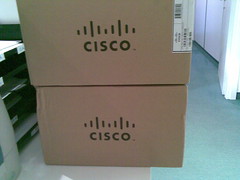One of the clear themes at last week's Cisco Live conference was that Cisco really wants us all to buy a single vendor solution and it won't be any surprise that the vendor they are recommending is themselves. The basic premise is that by buying Cisco you get an integrated solution that saves you time and money both up front when you're implementing and along the way as you maintain and upgrade your infrastructure. It's not a bad story, but to be true Cisco would need to have a more coherent and well integrated set of product offerings than they currently do.
Anyone who has worked with Cisco devices knows that there are variations between product lines when it comes to management and configuration. As an example ASA firewalls don't support "show users" which is a common command to see who else is logged on to a device. There are many other examples that are unrelated to the functionality differences that exist between different types of devices.
Dealing with Cisco is like dealing with a ten thousand headed monster where most of the heads would prefer not to talk to each other and communicate instead through product announcements.
Another example is setting up different product lines to work with Cisco's ACS. ACS is a proprietary Cisco offering that provides authentication and authorization services. You would think that the configuration syntax and behavior would be more or less identical across all of Cisco's products. You would be wrong. There are subtle and sometimes not so subtle differences that can cause deployment delays, confusion and frustration.
I've been on the receiving end of HP's pitch to buy into their access layer switches and it's fairly compelling. HP's switches are less expensive, more capable and from a command line perspective look more like IOS than the command line of some of Cisco's products. I've also been on the receiving end of some horrific and expensive HP support so as compelling as HP's pitch was I personally wasn't ready to jump ship.
If Cisco wants to sell their integrated vision they need to get their act together internally and start offering products that look like they are close relatives rather than distant cousins. They did this right a decade or so back when they came out with IOS for switches but have frequently failed since.
To be clear, I'm not claiming that IOS should be the language spoken by all Cisco devices. IOS offers an antiquated high cost interface to device management. Ideally though if you are going to make an effort to make an IOS like interface available you should do a better job on the implementation side by duplicating what has come before.
Really though Cisco needs to implement a management API that simplifies the task of configuration and make that API consistent across their entire line. Writing and debugging scripts that enumerate interfaces and do "for each" loops with logic to standardize interface configs should as much as possible be a thing of the past. Command line interfaces are nice, particularly for those of us who have been in the business for awhile but they should not be the primary means of management. Just to be sure I'm being clear here, Web browser GUI's that talk to a single logical device aren't the answer either.
Cisco also needs to streamline their product catalog and make sure that what remains is a line up that looks like it was designed from the get go to integrate quickly and easily if they want to argue with a straight face that they can lower companies Total Cost of Ownership.
Image by stars6 / Leonardo Rizzi via Flickr


No comments:
Post a Comment